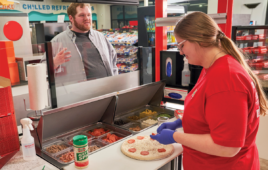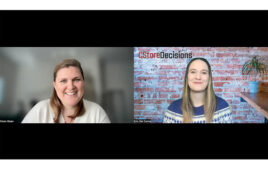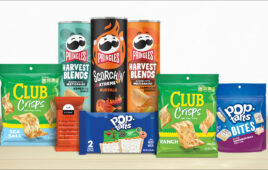 On Wednesday, Oct. 6, at the NACS Show, retailers flocked to educational sessions that offered key insights on hot topics to help them better their business.
On Wednesday, Oct. 6, at the NACS Show, retailers flocked to educational sessions that offered key insights on hot topics to help them better their business.
Mobile Apps
In a session titled, “Increasing Foot Traffic With Your App,” Jeffry Harrison, owner and president of Rovertown; John Nelson, CEO Vroom Delivery Inc.; and Chase Thomason, CEO, GOSKIP Inc., discussed using mobile app technology to better engage customers.
Today, the c-store industry is lacking when it comes to mobile app technology compared to competing channels. And it’s important for c-stores to get in the game, especially as mobile app usage has skyrocketed during the pandemic. Most customers have a mobile phone today. Having a branded app is key because it keeps your brand in your customer’s hand.
An average U.S. consumer spent more time using apps than watching TV in 2020, per Social Media Today. C-store apps are the 4th most frequented e-commerce apps by consumers, according to Clutch Co. And the opportunity is growing fast.
“You need to start now because each day that goes by, you’re going to lose that engagement opportunity with your consumer,” Harrison said.
The consumer behavior today of ‘get out of my way and give me what I want’ is expected to grow and that’s going to encourage the need for stores to become more digital, Thomason noted.
Key indicators that an integrated e-commerce app may be right for your chain include: Highly competitive market, community engagement, brand recognition, best value, customer loyalty/loyalty program.

Jeffry Harrison, owner and president of Rovertown; John Nelson, CEO Vroom Delivery Inc.; and Chase Thomason, CEO, GOSKIP Inc.
It’s important that c-stores realize they’re no longer competing just with other corner stores. Today the competition is coming from DoorDash, Amazon, Grubhub, goPuff, all of which have big money behind them.
As you look toward the future, to stay relevant, your convenience store has to have some type of e-commerce digital strategy, Thomason said. If you don’t, your c-store is going to fall behind as these companies that focus on having a real-time, on-demand fulfillment are going to win the customer.
When setting up your app, consider who you reach now and who you aspire to reach in terms of your target market. Determine how you will provide messaging and justify your ROI, Harrison noted. ‘Location, location, location’ now means where your app is on their phone, he added. “Are you buried in the back in a folder I never open or are you on the front page?” Harrison said. In other words, are you giving customers a reason to use the app frequently to order food, pay for gas, get loyalty points, etc.?
So you’re ready to add an app. Harrison outlined three app strategies:
White label app – cookie cutter, but will limit growth
Custom app – completely customized; costly, time consuming and could become outdated soon as technology continues to evolve
App Platform – newer option where you have a branded app and are plugging in solutions, which can help make us competitive as an industry
Grocery and convenience e-commerce is expected to reach $250 billion by 2025, Nelson noted. Key features you need for effective e-commerce programs include having a broad range of products.
“Basically you need to offer everything in your store, so you need a platform that will let you put thousands of SKUs online,” Nelson said.
Offer delivery. On average delivery brings in 10 times the volume of pickup orders.
And, you need to use data to drive ordering decisions. Drive larger baskets through upsells, suggested sells and offers. Get to know your consumer and what they like, Nelson said.
Promotion is key. Focus on digital marketing — particularly search and social media to drive awareness.
When it comes to adding delivery, there are three strategies:
Third party – The benefit is it’s easy; they sort out the logistics and it’s quick. The downsides are huge, however, because this is their app, their customer and they do not share the data and more and more they are competing with you, Nelson said. DashMarts, for example, are popping up around the country, and they can out price you because they own the retail and the delivery. Still third-party delivery can be a good solution to start out with, but you should very quickly be thinking how to move to one of the next models, Nelson advised.
Hybrid — This means offering proprietary ordering, with a combination of third-party and self delivery. This allows retailers to launch quickly across platforms, and then as volume goes up you can layer in your own drivers.
DIY — This includes proprietary ordering and self delivery, and it’s what the speakers recommend because you control the last mile in transaction.
Today, apps also allow for scan-and-go transactions and the data shows strong results, for example: 4.95/5.0 customer satisfaction, 60% shopper retention, basket size up 4.5% and shopper spend up 6%, Thomason noted.
When employees at the store are users of the scan-and-go technology, data shows that organic growth naturally develops. Put one clear, direct sign about scan and go in the store and make sure it doesn’t have other promotional signs around it, to ensure it stands out and shoppers see it.
When launching scan and go, start with a promotion to create awareness, such as dollars off the first transaction using scan and go. When stores start with a promotion, there is a corresponding spike in usage and because scan and go has such a high retention rate, customers continue using the technology.
Product Assortment
In a session titled, “Determining the Perfect Product Mix,” Bill Barnes, manager, category leadership, PepsiCo and Ellen Webb, senior director, category management, PepsiCo, discussed optimizing assortment.
Having the right assortment is critical in winning shoppers. It’s important for c-store retailers to look beyond historical performance to determine the optimal assortment for their stores because you’re building your assortment for the shoppers of today and next week — not yesterday. What’s more, your assortment decisions need to align with broader strategic goals.
Among tips and takeaways, one key strategy Barnes pointed to is making sure that beverage categories that meet similar consumer needs are adjacent in the cold vault to help them perform better. For example, in 11 test stores, PepsiCo moved ready-to-drink coffee and energy drinks to a position adjacent to each other. It saw a similar opportunity for kombucha and juice to sit adjacent to each other because customers are looking for more opportunities to put good things in their bodies today and juice and kombucha both fill that same need, Barnes noted.
In the 11 test stores, over three months, those adjacencies drove business. “When we look at test vs. control stores, the velocity growth on a per SKU basis is growing at a rate of four times higher (at test stores),” Barnes said.
Category growth was also more evenly spread out across segments in the test stores. When c-stores are driving growth across segments, they’re pulling from different levers for their growth and that diversification minimizes a store’s exposure to risk.
The speakers advised that retailers identify category and execution opportunities that drive retail strategy, meet future consumer demand (not historical) and align with operational parameters. Develop planograms that deliver on identified opportunities. Integrate localized insights across flavor, pack and behavior. Collaborate to align on maser planograms. Most of all, take the time to test things out in your stores and see what works for you and your shoppers.
The NACS Show continues through Oct. 8 at McCormick Place in Chicago.



